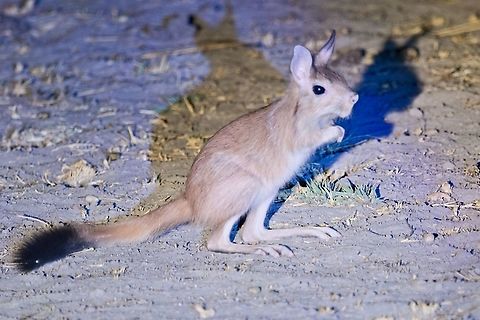
Appearance
The springhare resembles a small kangaroo, with well-developed hind legs, short front legs, and a long tail which compromises half of its body length. As well as a long tail, springhares have relatively large eyes and ears. Adults can attain 80 cm in length and weigh an average of 2.7 - 3.5 kg. Similar to kangaroos, they are also saltatorial animals who use their tails for balance. Springhares are reported to be able to make hops of 20 cm and leaps of 2 m.Springhares have long, soft fur, which shortens around the legs, heads, and ears. The colour of this mammal varies from a reddish-brown on its upperparts to an off-white belly and a black tip on the tail. Sometimes the ear tips are also black. Young springhares have finer and fluffier fur and usually have black patches of fur under their hind feet and in a patch of black under their tail base.
Springhares have a different number of toes on their forelegs and hindlegs. Their short forelegs have five digits, each ending in a long, sharp, curved claw, which can be 16 millimetres long. their long hindlegs have four digits, three of which are visibly developed and equipped with a strong triangular nail.
The oldest recorded individual was 88 months old.
Behavior
Springhares are nocturnal animals, who forage during the night and retreat to a burrow during the day. While sleeping in their burrows, springhares sleep standing, with their head and forelimbs bent down in between their hindlegs, and their tail wrapped around their feet.Habitat
Springhares live throughout semi-arid areas in southern Africa, preferentially in sandy plains and pans with short grasses. In agricultural areas, springhares can be considered a pest due to their destructive feeding on crops. However, they are not currently considered under an impeding risk of extinction.Reproduction
Springhares breed throughout the year and have a gestation period of about 77 days. The females give birth to a single young about three times a year. Moreover, females can be lactating and in the early stages of pregnancy at the same time.Their ability to reproduce year-round is thought to be attributable to their highly selective diet, their wide range of foods available to them, and their behavioural and physical adaptations to living in arid and semi-arid conditions.
Springhares give birth in a burrow to a furred young of about 250 - 300 g. Springhares usually give birth to a single young, but birthing twins is known to occur. While the young remains at the burrow, the mother stops the usual behaviour of moving burrows every couple of days. She is bound to the burrow where her young is, who depends entirely on her milk. The young stays in the burrow for approximately seven weeks until they attain a body weight of approximately 1.3 kg. The extended period of parental care may help mitigate a birthrate that is, among rodents, remarkably low.
Food
Springhares are herbivorous, eating a variety of plant matter, such as roots, stems, leaves, and seeds. However, springhares are picky eaters and often leave abundant plant materials behind in their feeding grounds. On occasion, springhares may feed on insects such as beetles or locusts, or even carrion.Springhares feed at night and can range 150 – 400 m away of one of their burrows. They may feed in large groups of up to nine individuals. In these instances, they do not display aggression or territorial behaviours.
Predators
These animals are predated upon by a variety of predators, including humans; at least 21 species prey on springhares in the Kalahari.Uses
San and baTswana people both traditionally make use of springhares. Both groups of people hunt springhares, which can yield up to 1360 g of meat. Aside from the meat, San people use springhare skins for a variety of uses, such as bags, mats, karosses and hats. The tail provides sinew for sewing and an ornamental belt which produces sounds can be made by tying springhare toes on a string.References:
Some text fragments are auto parsed from Wikipedia.